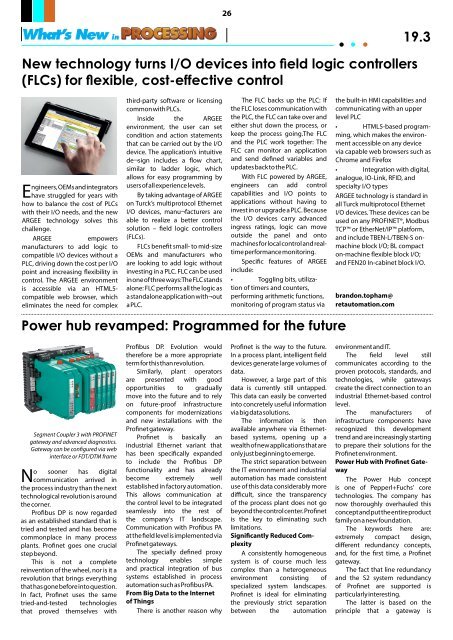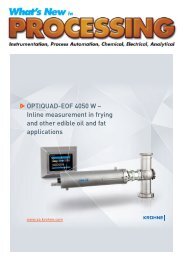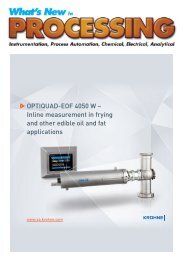WNIP May June 19.3 Digital
Wnip may june 19 3 digital
Wnip may june 19 3 digital
You also want an ePaper? Increase the reach of your titles
YUMPU automatically turns print PDFs into web optimized ePapers that Google loves.
26<br />
New technology turns I/O devices into field logic controllers<br />
(FLCs) for flexible, cost-effective control<br />
Engineers, OEMs and integrators<br />
have struggled for years with<br />
how to balance the cost of PLCs<br />
with their I/O needs, and the new<br />
ARGEE technology solves this<br />
challenge.<br />
ARGEE<br />
empowers<br />
manufacturers to add logic to<br />
compatible I/O devices without a<br />
PLC, driving down the cost per I/O<br />
point and increasing flexibility in<br />
control. The ARGEE environment<br />
is accessible via an HTML5-<br />
compatible web browser, which<br />
eliminates the need for complex<br />
third-party software or licensing<br />
common with PLCs.<br />
Inside the ARGEE<br />
environment, the user can set<br />
condition and action statements<br />
that can be carried out by the I/O<br />
device. The application’s intuitive<br />
de¬sign includes a flow chart,<br />
similar to ladder logic, which<br />
allows for easy programming by<br />
users of all experience levels.<br />
By taking advantage of ARGEE<br />
on Turck’s multiprotocol Ethernet<br />
I/O devices, manu¬facturers are<br />
able to realize a better control<br />
solution – field logic controllers<br />
(FLCs).<br />
FLCs benefit small- to mid-size<br />
OEMs and manufacturers who<br />
are looking to add logic without<br />
investing in a PLC. FLC can be used<br />
in one of three ways:The FLC stands<br />
alone: FLC performs all the logic as<br />
a standalone application with¬out<br />
a PLC.<br />
The FLC backs up the PLC: If<br />
the FLC loses communication with<br />
the PLC, the FLC can take over and<br />
either shut down the process, or<br />
keep the process going.The FLC<br />
and the PLC work together: The<br />
FLC can monitor an application<br />
and send defined variables and<br />
updates back to the PLC.<br />
With FLC powered by ARGEE,<br />
engineers can add control<br />
capabilities and I/O points to<br />
applications without having to<br />
invest in or upgrade a PLC. Because<br />
the I/O devices carry advanced<br />
ingress ratings, logic can move<br />
outside the panel and onto<br />
machines for local control and realtime<br />
performance monitoring.<br />
Specific features of ARGEE<br />
include:<br />
• Toggling bits, utilization<br />
of timers and counters,<br />
performing arithmetic functions,<br />
monitoring of program status via<br />
Power hub revamped: Programmed for the future<br />
<strong>19.3</strong><br />
the built-in HMI capabilities and<br />
communicating with an upper<br />
level PLC<br />
• HTML5-based programming,<br />
which makes the environment<br />
accessible on any device<br />
via capable web browsers such as<br />
Chrome and Firefox<br />
• Integration with digital,<br />
analogue, IO-Link, RFID, and<br />
specialty I/O types<br />
ARGEE technology is standard in<br />
all Turck multiprotocol Ethernet<br />
I/O devices. These devices can be<br />
used on any PROFINET®, Modbus<br />
TCP or EtherNet/IP platform,<br />
and include TBEN-L/TBEN-S onmachine<br />
block I/O; BL compact<br />
on-machine flexible block I/O;<br />
and FEN20 In-cabinet block I/O.<br />
brandon.topham@<br />
retautomation.com<br />
Segment Coupler 3 with PROFINET<br />
gateway and advanced diagnostics.<br />
Gateway can be configured via web<br />
interface or FDT/DTM frame<br />
No sooner has digital<br />
communication arrived in<br />
the process industry than the next<br />
technological revolution is around<br />
the corner.<br />
Profibus DP is now regarded<br />
as an established standard that is<br />
tried and tested and has become<br />
commonplace in many process<br />
plants. Profinet goes one crucial<br />
step beyond.<br />
This is not a complete<br />
reinvention of the wheel, nor is it a<br />
revolution that brings everything<br />
that has gone before into question.<br />
In fact, Profinet uses the same<br />
tried-and-tested technologies<br />
that proved themselves with<br />
Profibus DP. Evolution would<br />
therefore be a more appropriate<br />
term for this than revolution.<br />
Similarly, plant operators<br />
are presented with good<br />
opportunities to gradually<br />
move into the future and to rely<br />
on future-proof infrastructure<br />
components for modernizations<br />
and new installations with the<br />
Profinet gateway.<br />
Profinet is basically an<br />
industrial Ethernet variant that<br />
has been specifically expanded<br />
to include the Profibus DP<br />
functionality and has already<br />
become extremely well<br />
established in factory automation.<br />
This allows communication at<br />
the control level to be integrated<br />
seamlessly into the rest of<br />
the company's IT landscape.<br />
Communication with Profibus PA<br />
at the field level is implemented via<br />
Profinet gateways.<br />
The specially defined proxy<br />
technology enables simple<br />
and practical integration of bus<br />
systems established in process<br />
automation such as Profibus PA.<br />
From Big Data to the Internet<br />
of Things<br />
There is another reason why<br />
Profinet is the way to the future.<br />
In a process plant, intelligent field<br />
devices generate large volumes of<br />
data.<br />
However, a large part of this<br />
data is currently still untapped.<br />
This data can easily be converted<br />
into concretely useful information<br />
via big data solutions.<br />
The information is then<br />
available anywhere via Ethernetbased<br />
systems, opening up a<br />
wealth of new applications that are<br />
only just beginning to emerge.<br />
The strict separation between<br />
the IT environment and industrial<br />
automation has made consistent<br />
use of this data considerably more<br />
difficult, since the transparency<br />
of the process plant does not go<br />
beyond the control center. Profinet<br />
is the key to eliminating such<br />
limitations.<br />
Significantly Reduced Complexity<br />
A consistently homogeneous<br />
system is of course much less<br />
complex than a heterogeneous<br />
environment consisting of<br />
specialized system landscapes.<br />
Profinet is ideal for eliminating<br />
the previously strict separation<br />
between the automation<br />
environment and IT.<br />
The field level still<br />
communicates according to the<br />
proven protocols, standards, and<br />
technologies, while gateways<br />
create the direct connection to an<br />
industrial Ethernet-based control<br />
level.<br />
The manufacturers of<br />
infrastructure components have<br />
recognized this development<br />
trend and are increasingly starting<br />
to prepare their solutions for the<br />
Profinet environment.<br />
Power Hub with Profinet Gateway<br />
The Power Hub concept<br />
is one of Pepperl+Fuchs' core<br />
technologies. The company has<br />
now thoroughly overhauled this<br />
concept and put the entire product<br />
family on a new foundation.<br />
The keywords here are:<br />
extremely compact design,<br />
different redundancy concepts,<br />
and, for the first time, a Profinet<br />
gateway.<br />
The fact that line redundancy<br />
and the S2 system redundancy<br />
of Profinet are supported is<br />
particularly interesting.<br />
The latter is based on the<br />
principle that a gateway is

















